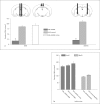Estrogen-induced sexual incentive motivation, proceptivity and receptivity depend on a functional estrogen receptor alpha in the ventromedial nucleus of the hypothalamus but not in the amygdala
- PMID: 19887773
- PMCID: PMC2918652
- DOI: 10.1159/000255766
Estrogen-induced sexual incentive motivation, proceptivity and receptivity depend on a functional estrogen receptor alpha in the ventromedial nucleus of the hypothalamus but not in the amygdala
Abstract
The display of copulatory behaviors usually requires the presence of a mate and is, therefore, preceded by a search for and approach to a potential partner. The intensity of approach behaviors is determined by a process labeled sexual incentive motivation. Although it is known that female sexual motivation depends on estrogens, their site of action within the brain is unknown. In the present experiment, we obtained data relevant to this issue. An shRNA encoded within an adeno-associated viral (AAV) vector directed against the estrogen receptor alpha (ERalpha) gene (or containing a nonsense base sequence as a control treatment) was injected bilaterally into the ventromedial nucleus of the hypothalamus (VMN) or the posterodorsal amygdala (MePDA) of female rats. After an 80% reduction of the number of ERalpha in the VMN, sexual incentive motivation was absent after treatment with estradiol and progesterone. Proceptivity and receptivity were also much reduced, while the number of rejections was enhanced. Suppression of the ERalpha in the MePDA lacked these effects. Likewise, the inactive control AAV vector failed to modify any behavior. Thus, the ERalpha in the VMN, but not in the MePDA, is important for proceptivity and receptivity as well as for sexual incentive motivation. These results show that ERalpha in the VMN is crucial for the entire sequence of behavioral events from the processes leading to the establishment of sexual contact until the accomplishment of copulatory behaviors.
Copyright 2009 S. Karger AG, Basel.
Figures




References
-
- Blaustein JD, Erskine MS. Feminine sexual behavior: cellular integration of hormonal and afferent information in the rodent brain. In: Pfaff DW, Arnold AP, Etgen AM, Fahrbach SE, Rubin RT, editors. Hormones, Brain and Behavior. vol 1. New York: Academic Press; 2002. pp. 139–214.
-
- Ogawa S, Eng V, Taylor J, Lubahn DB, Korach KS, Pfaff DW. Roles of estrogen receptor-α gene expression in reproduction-related behaviors in female mice. Endocrinology. 1998;139:5070–5081. - PubMed
-
- Rissman EF, Early AH, Taylor JA, Korach KS, Lubahn DB. Estrogen receptors are essential for female sexual receptivity. Endocrinology. 1997;138:507–510. - PubMed
-
- Mazzucco CA, Walker HA, Pawluski JL, Lieblich SE, Galea LAM. ERα, but not ER β, mediates the expression of sexual behavior in the female rat. Behav Brain Res. 2008;191:111–117. - PubMed

